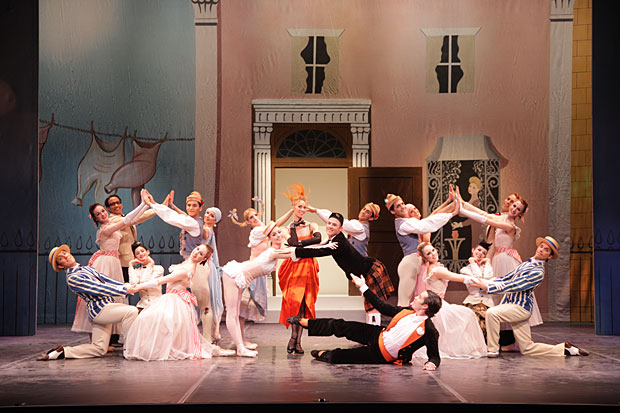
© Frank Atura. (Click image for larger version)
Sarasota Ballet
A Knight of the British Ballet: Valses Nobles et Sentimentales, Tweedledum and Tweedledee, The Walk to the Paradise Garden, “Friday’s Child” from Jazz Calendar, Sinfonietta (2nd Movment)
★★★✰✰
New York, Joyce Theater
9 August 2016
www.sarasotaballet.org
www.joyce.org
Frederick Ashton Comes to Town
In the midst of the August doldrums, Sarasota Ballet is paying New York a visit with a program of works by Frederick Ashton, the British twentieth-century choreographer who has become the company’s calling card. It may seem odd that this medium-sized company based on the Gulf Coast should be one of the world’s major repositories of Ashton’s work, but such is the diaspora of ballet. For the last decade, the company has been led by Iain Webb, a former dancer with the Sadler’s Wells Royal Ballet and the Royal Ballet, and his wife, Margaret Barbieri, was also a longtime principal at the Sadler’s Wells Royal Ballet. British ballet runs in the company’s veins.
Barbieri and Webb have shown a real passion for Ashton, acquiring twenty-three of his works, mostly chamber-sized but also more elaborate productions like La Fille Mal Gardée and Enigma Variations. The company has previously visited New York only once, with the charming winter-themed Les Patineurs, which it performed at Fall for Dance in 2014. The program for this visit is a bit of a medley, with one substantial work – Valses Nobles et Sentimentales – followed by a series of sketches and excerpts, closing with the witty and silly Façade, from 1931. Unfortunately, all the music is canned.
Because of their smaller scale, the short works and Façade were the most suited to the Joyce’s rather circumscribed stage. Façade – a suite of skits set to witty music by William Walton that spoofs Scottish music, yodeling, the tango, the foxtrot – benefits greatly from being seen close up. One can enjoy the dancers’ expressions: insouciant, delighted, seductive, vacuous, etc. I’ve seen the company dance it with more verve, notably during its 2014 Ashton Festival on its home turf. But the dancers began to loosen up about halfway through. Like a lot of Ashton, Façade is both silly and knowing, stylish almost despite itself.
In one number, a milkmaid with upturned braids happily milks her cow, while three strapping young men form the body of the bovine, down to its swishing tale. During a foxtrot for two couples, one young man keeps shaking his head with delight to show what a bright young thing he is; the other glowers, doing his best to look unamused. The girls are just delighted. David Tlaiye was wonderfully slithery as the bejeweled and solipsistic seducer in the Tango-Pasodoble. For the finale, everyone joins in a happy tarantella, a real music-hall number reminiscent of the big gallop in the last act of Ashton’s much later Sylvia. Like a post-modernist before his time, Ashton loved mixing high and low.

© Frank Atura. (Click image for larger version)
Sarasota Ballet is especially good about bringing back Ashton ballets that no-one else does, like his Jazz Calendar (1968) and Sinfonietta (1967). The Adagio from the latter was an especially striking addition to the program. It is a kind of extension of Monotones, which had premiered just a few years earlier. Here, too, the dancers are in head-to-toe white, including skullcaps; the light is cosmic and the movement almost disembodied. Instead of a trio, we have five men and one woman, who barely seems to touch the ground. She swoops and floats, supported by the men, who function like invisible handlers, Japanese puppet masters. For a good long while she hovers in arabesque, passed unobtrusively from one man to the next. The sheer duration of the levitation, coupled with her utter serenity as she floats there, arms held en couronne, begins to create the sensation of bending time. (Victoria Hulland maintains just the right note of impassivity and atemporality.) The ballet includes other surprising elements: two men who support each other in a series of seesawing arabesques; beautiful six-person figures; off-balance partnering more reminiscent of Balanchine than of Ashton; and a striking sunburst made up of six legs, twice as many as in Balanchine’s Apollo. (But who’s counting?)
“Friday’s Child,” from Jazz Calendar is a slight but stylish pas de deux set to a slow jazz number by Richard Rodney Bennett, heavy on the horns. With its two-toned unitards and caps and hippy moves, it would look just right in a movie musical like An American in Paris. Like Leslie Caron in that movie, Ellen Overstreet was both sexy and demure. The Walk to the Paradise Garden, a late pas de deux inspired by the bedroom scene from Shakespeare’s Romeo and Juliet, is a little heavy on the hyper-charged, Bolshoi-style lifts, but ends in a most unexpected, and rather chilling way. A male figure enters, wearing a cape; slowly, one after the other, the two lovers are drawn toward him, still reaching for each other, but somehow accepting of the death that awaits them. The music is by Frederick Delius, from his opera A Village Romeo and Juliet. The last of the short works, Tweedledum and Tweedledee, is a little gala piece full of simple gags made funnier by the way they are set on the music. But it needs to be done with a broader sense of humor; tonight it fell rather flat.
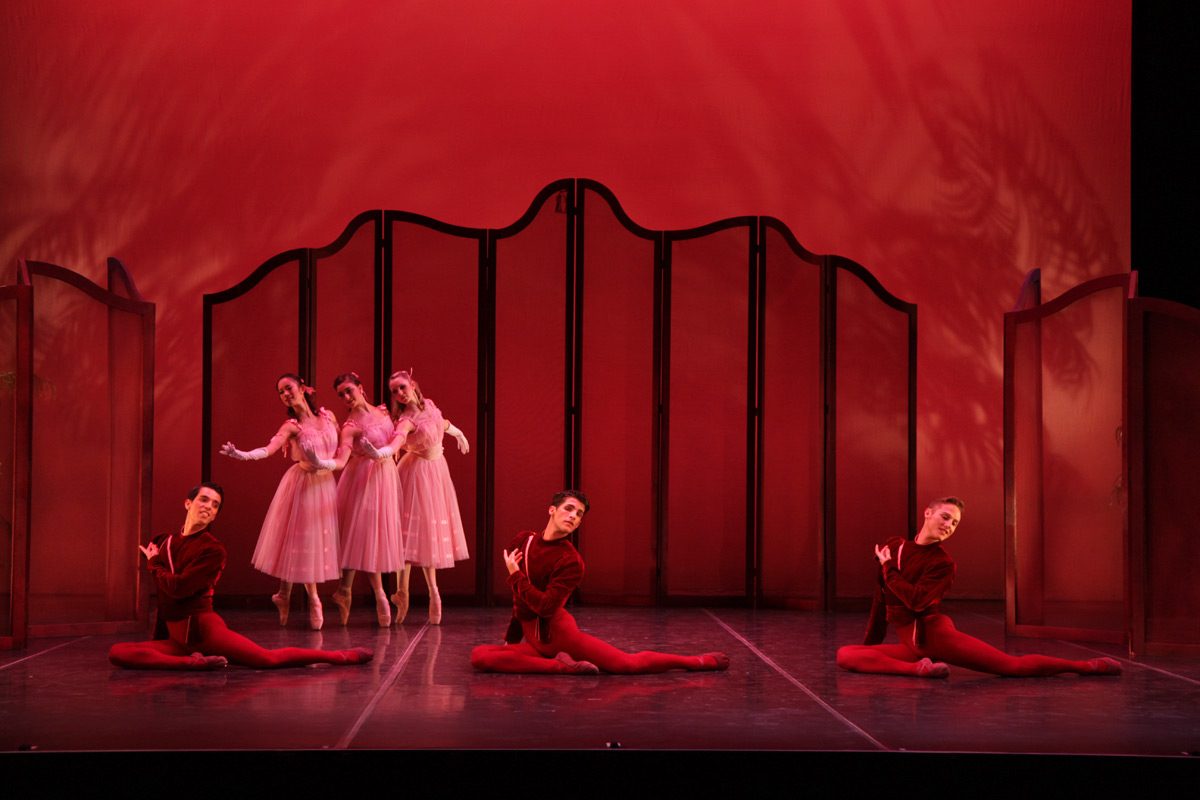
© Frank Atura. (Click image for larger version)
Valses Nobles et Sentimentales, set to Ravel’s eponymous music, also fell somewhat short. Maybe the dancers were nervous – it was the first piece on the program – or the Joyce stage is too small, or the décor looks too old-fashioned. (The canned music was certainly part of the issue.) But somehow this ballet, which should suggest the glamour and doomed elegance of a lost world, never quite took flight. The setting is a faded red ballroom, in which black screens play the role of barrier, window and mirror. Dancers float behind them, or peer through them at their partners, as if dreaming of another time. A woman (Danielle Brown) is carried in by two men in a soaring split, her calves supported by their shoulders. At the end of the ballet, she rises and falls behind a screen, as if imprisoned in a circuit of perpetual motion. Everyone flirts, but a certain pessimism lingers in the air. The dancers’ long gloves focus the audience’s attention to the elaborate twists and flips of the wrist, the long line of the arms. Ashton’s use of the upper body is so rich: torqued and three-dimensional, always creating a softness here and a pull there. The line of the neck is exaggerated, giving a sense of sensuality and vulnerability.
But the drama didn’t blossom tonight; the dancers looked constrained by the space and a little tense. Things will probably improve over the course of the week. The Sarasota dancers, who do so much Ashton, truly understand the style. As the evening progresses, one feels it more and more.












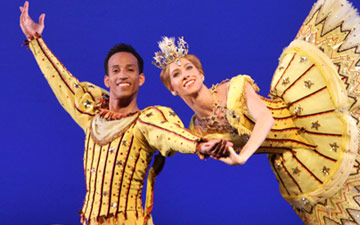
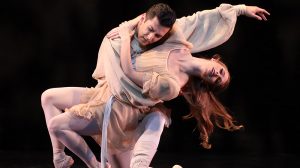
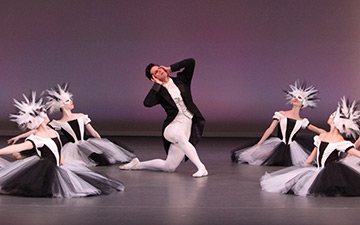


You must be logged in to post a comment.